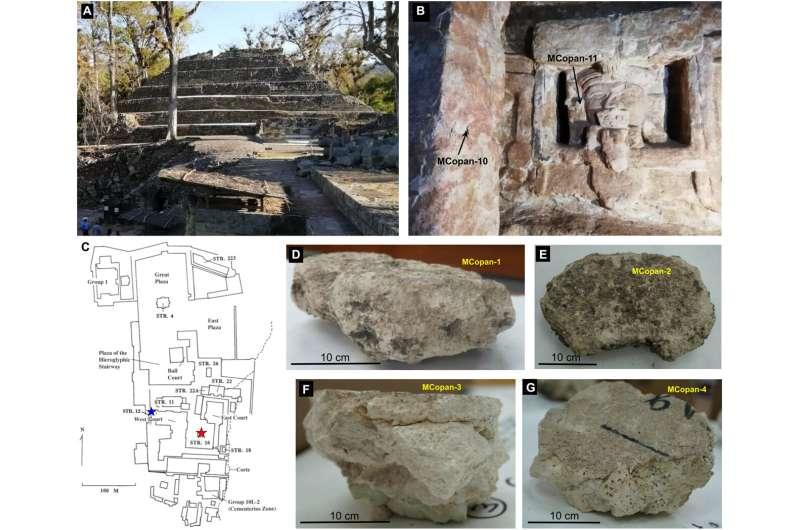Bob Yirka , Phys.org
Source - https://phys.org/news/2023-04-secret-ingredient-durable-mayan-plaster.html
 Maya plasters from Copan archaeological site (Honduras). (A) General view of Structure 10L-16 (Late Classic building dedicated in 776 CE) (22). Within this structure is located substructure “Rosalila” (540 to 655 CE), the best example of a complete Classic temple in the Maya area, whose surface is decorated with pinkish lime plaster and stucco masks (B). Samples MCopan-10 and MCopan-11 were collected from the latter location, shown (marked with a red star) in the site map (C). Samples MCopan-1 (D) and MCopan-2 (E) corresponding to coarse lime plasters from the interior wall of the central room of Structure 12, ca. 700 CE [blue star in (C)]. Samples MCopan-3 (F) and MCopan-4 (G) corresponding to a fine two-layer plaster (“stucco”) floor from the mid-Classic (500 to 700 CE) collected in tunnel 74 at Structure 10L-16. (C) adapted from (22) with permission from Springer Nature. Credit: Science Advances (2023). DOI: 10.1126/sciadv.adf6138
Maya plasters from Copan archaeological site (Honduras). (A) General view of Structure 10L-16 (Late Classic building dedicated in 776 CE) (22). Within this structure is located substructure “Rosalila” (540 to 655 CE), the best example of a complete Classic temple in the Maya area, whose surface is decorated with pinkish lime plaster and stucco masks (B). Samples MCopan-10 and MCopan-11 were collected from the latter location, shown (marked with a red star) in the site map (C). Samples MCopan-1 (D) and MCopan-2 (E) corresponding to coarse lime plasters from the interior wall of the central room of Structure 12, ca. 700 CE [blue star in (C)]. Samples MCopan-3 (F) and MCopan-4 (G) corresponding to a fine two-layer plaster (“stucco”) floor from the mid-Classic (500 to 700 CE) collected in tunnel 74 at Structure 10L-16. (C) adapted from (22) with permission from Springer Nature. Credit: Science Advances (2023). DOI: 10.1126/sciadv.adf6138
A team of mineralogists and geologists at the University of Granada has discovered the secret behind the durability of ancient Maya plaster. In their study, reported in Science Advances, the group studied samples of the ancient plaster and consulted with descendants of Mayans to learn more about how the ancient plaster was made.
Prior research has shown that the Mayans, along with many other ancient civilizations, knew how to make plaster, which is typically used to hold bricks together or to cover stone to give it a more appealing look. Prior research has also shown that not all ancient plasters were the same—some were much more durable than others. Stone structures built in what is now Honduras, for example, have lasted longer than structures built in other parts of the Aztec empire due to their durable plaster coverings. In this new effort, similar to recent work by another team that uncovered the secret to super-durable Roman concrete, the group from Spain discovered the secret ingredient in the plaster that made it so strong.
The team studied samples of it in Honduras using X-ray machines and electron microscopes. They discovered organic material in the mix, something similar to a carbohydrate. Intrigued by the finding, they consulted with masons currently living in the area where the old buildings had been constructed and also with Mayan descendants living near Copán. That led them to two trees: the chukum and the jiote, both of which still grow in the area today. More specifically, they looked at the trees' sap. Legend had it that adding the sap to plaster made it more durable.
To find out if the sap was the special ingredient they were looking for, the team created their own batch of plaster. The typical process for creating plaster involves calcination (baking) of carbonate rock material, such as limestone, and then mixing in water while allowing the material to react with carbon dioxide in the air. The result is known commonly as lime mortar. The team followed this formula but also mixed in sap and then used it as a plaster. Testing showed that it had the same properties as the ancient Maya plaster, which included water solubility, making it impervious to the extreme Honduran humidity.
Carlos Rodriguez-Navarro et al, Unveiling the secret of ancient Maya masons: Biomimetic lime plasters with plant extracts, Science Advances (2023). DOI: